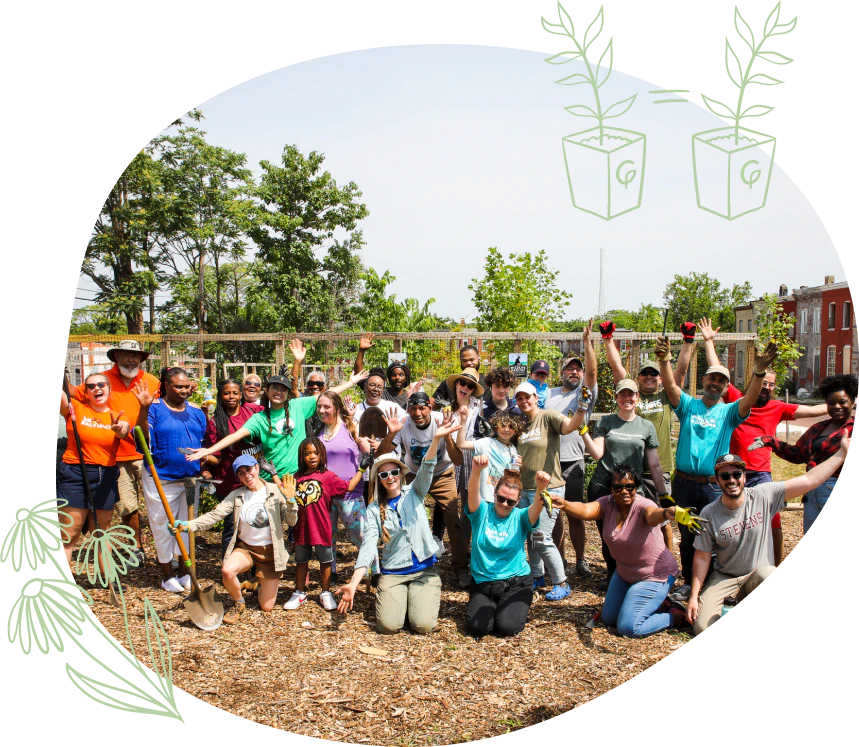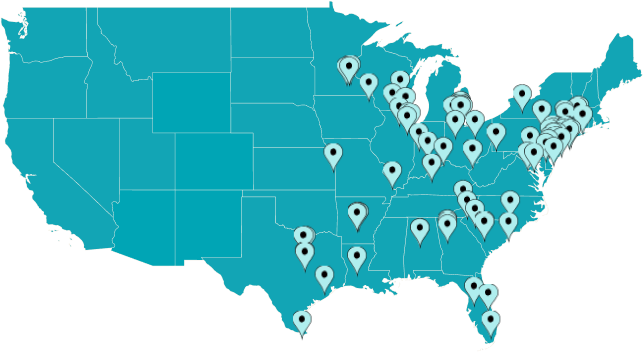Community Garden Donations
Native Plants for Schools and Community Projects
Amplifying our collective impact on wildlife and the planet through native plant donations to community gardens and public spaces.


87
Community Gardens Donated
24
U.S. States
19,776
Native Plants Donated

Supporting Wildlife, Healing Communities
When you shop at Garden for Wildlife®, not only do you get to bask in the beauty of nature that your wildlife garden brings, you're also contributing to the well-being of your community.
Communities that have received a garden donation benefit immensely from the establishment of a new public wildlife garden. These gardens act as hubs of biodiversity, attracting and supporting a wide range of wildlife species. Studies show that wildlife presence can double within just one season when native plants are used and spending time in nature has been shown to reduce stress and anxiety.
When you garden for wildlife, everyone wins! Join the movement to create a healthier, more vibrant community for all.
A Wild Vision for a Biodiverse Future
In the spring of 2024, we launched the inaugural Wild Visions Habitat Creation Challenge, supporting fourteen university student groups to plant native gardens in the DC area. The donated native plant gardens were planted during Earth Week (April 20-28, 2024), resulting in a total of over 5,000 square feet of new wildlife habitat in the DMV.
Beyond creating habitats, the Wild Visions program fostered eco-agency among students, allowing them to address the biodiversity crisis through creativity and community care. Additionally, greening DC's urban landscape with these gardens bring lasting public health benefits to the community, including stress relief, while encouraging a deeper bond with nature.

How It Works
The native plant donations made possible by your purchases support communities that are committed to building more resilient, healthy, and equitable places for people — and wildlife — to thrive, including Parks & Recreation, Public-Service Shelters, Schools, Places of Worship, and Historically-Marginalized Communities.

1. You buy a plant from gardenforwildlife.com and we bank a plant for donation.

2. Local schools and community organizations apply for a garden donation.

3. When plants in the "plant bank" match a community request, we donate a wildlife garden to that community.
Garden Donation Stories
See the impact of our free native plant donations firsthand. We're proud to have provided free native plants to help create these wildlife habitats within local communities. Learn how our native plant donation program transformed unused spaces into biodiverse gardens that attract pollinators and provide food and shelter for birds, butterflies, and beyond.
Frequently Asked Questions
When did the community garden donation program start?
We started tracking every native plant sale and building our free native plant donation inventory on January 1, 2023. We donated our first free wildlife garden native plants in the early summer of 2023.
How does a community organization request a garden donation?
If your group is interested in receiving free native plants, simply fill out our donation request form. If you meet the specified requirements, you will be approved as a recipient and placed on the waitlist for a garden donation. When the number of native plant donations in the plant bank match your request, you'll receive a free community garden!
What are the requirements to qualify for a garden donation?
To receive a wildlife garden donation, the recipient must agree to:
- Plant in the approved space within three days of plant delivery.
- Adequately maintain the wildlife garden for a minimum of five years.
- Display provided signage noting that the plants were donated by Garden for Wildlife by the National Wildlife Federation.
- Cover the costs of plant delivery (stated below)
Recipients must also agree to work with Garden for Wildlife staff to capture stories and photos of the space before and after that will be shared on our website and social media.
How many plants are provided for each garden?
Recipients will receive 150 native plants per donation.
How does an approved community organization receive their plants?
Once the plant bank inventory contains a grouping of plants that match with an approved recipient, those native plants will be sent, along with educational and instructional materials and branded signage, to the recipient for planting their new wildlife garden. The recipient is responsible for paying for delivery costs.
How are plant bank donations matched to community organizations?
For a grouping of plants to match with an approved recipient, the plants need to:
- Be native to the specific location (eco-region) where they’ll be planted
- Be in a state of growth that is ready for shipping and planting success
It also needs to be an appropriate time of year for planting in the location (i.e., not too cold for the plants to survive) and a good time for the recipient to receive the plants and plant them within 3 days of delivery.
Once all of these conditions are met, the recipient will be notified, and the plant delivery will be arranged.
What are the shipping costs? Are they covered as part of the donation?
The recipient of the donated plants is responsible for paying delivery costs. Shipping per donation 150 plant donation is $25 + tax.
Can a community garden become a Certified Wildlife Habitat?
Yes! We strongly encourage all community garden donation recipients to include a water source in their new wildlife garden and become a National Wildlife Federation Certified Wildlife Habitat.
This allows schools and other community groups to create safe spaces for wildlife that are accessible to everyone in their neighborhoods.
How do I get native plants for free?
Through Garden for Wildlife's community garden donation program, eligible schools, parks, and nonprofit community groups can get native plants for free, plus the cost of shipping.
This allows these spaces to create biodiverse wildlife gardens accessible to neighborhoods while bringing the benefits of native plants to more people.
Do you need help paying for shipping? Earn a garden through our native plant fundraising program and shipping is free!
What are some examples of native plant species that you donate?
We select plants native to each recipient's eco-region. Our most popular donated plants include native milkweed, asters, goldenrod, cardinal flower, and coneflowers.
Check out our ZIP code native plant finder to see exactly what native plants suit your outdoor space and project.
Our community has planted over
850,000+
square feet of wildlife habitat
Join the Movement
1. Plant a Wildlife Garden
Find the perfect plants for your region, and get step-by-step planting guides.
2. Bee the Change
Inspire others by sharing your native plant journey with us and educating your community on the many benefits of native plants.
3. Nourish Your Mind
Explore our library of resources and master the knowledge of native plants and sustainable gardening.